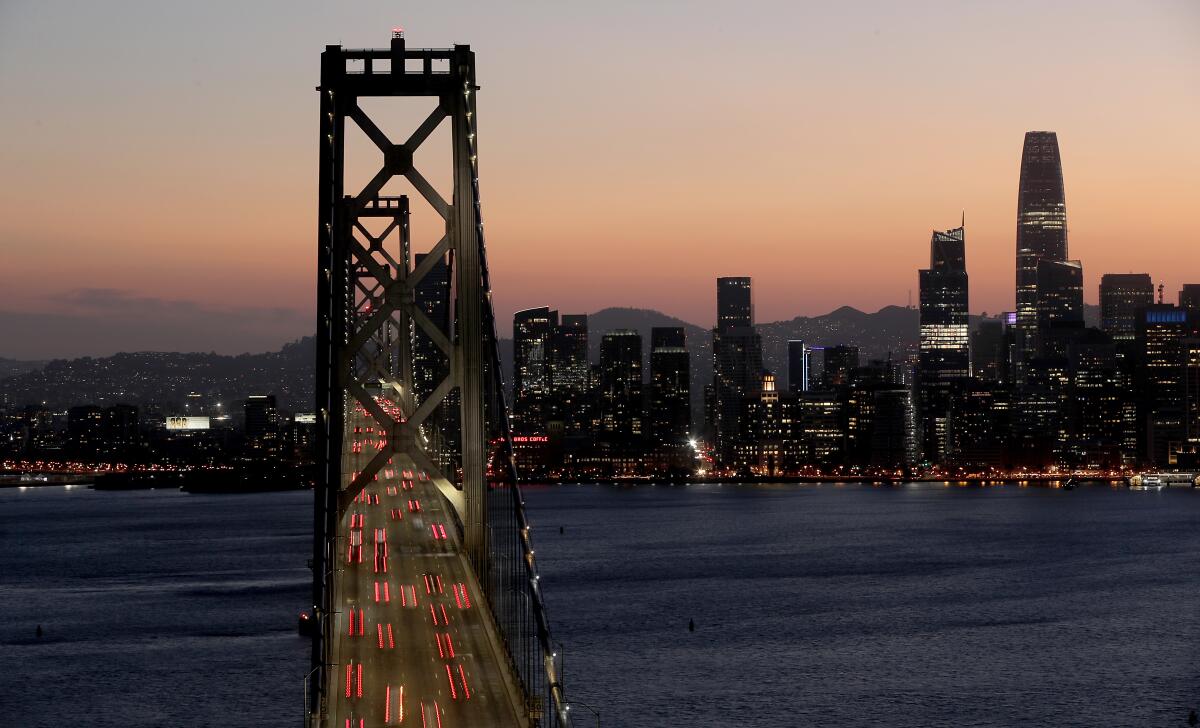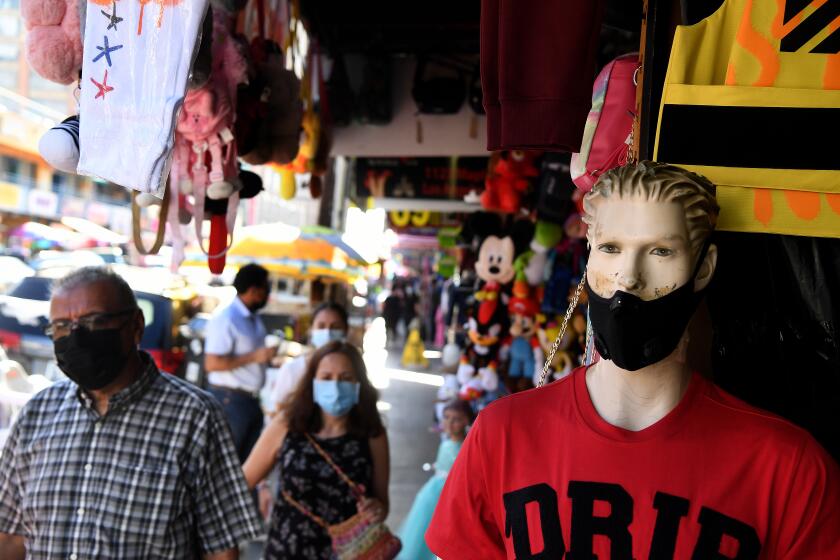Bay Area tightens COVID-19 restrictions; Santa Clara County orders travel quarantine

- Share via
SAN FRANCISCO — As the COVID-19 pandemic rapidly worsens across California, San Francisco and San Mateo counties on Saturday were moved into the state’s most restrictive tier, which forces the closure of indoor gyms and movie theaters.
At the same time, Santa Clara County issued its own tightened COVID-19 rules that in some ways are stricter than the ones issued by Los Angeles County on Friday. Under Santa Clara County’s directive, people must quarantine for 14 days after returning from travel of more than 150 miles, hotels will be open for only essential travel or isolation and quarantine, and nonessential retail establishments will be limited to 10% of capacity indoors, down from the current cap of 25%.
The backward steps come as statewide hospitalizations related to COVID-19 have tripled in the last month, exceeding their summer peak.
According to data released Sunday by the state Department of Public Health, 7,415 people infected with the coronavirus were in hospitals statewide Saturday, breaking the all-time high of 7,170 set in July. The number of COVID-19 patients in California’s hospitals has tripled since Halloween, when it was about 2,500.
In all, more than 1.2 million people have been infected with the coronavirus and more than 19,100 have died in California.
San Francisco had been able to avoid the most restrictive, purple tier of the state’s color-coded reopening framework, but the rate of new coronavirus cases there has continued to surge in recent days. In just the last six weeks, weekly coronavirus cases have more than quadrupled, from about 200 a week in mid-October to about 900 a week now.
A Times analysis published Friday found that most California counties are now suffering their worst daily new coronavirus case rates of the pandemic, surpassing even the summer surge that forced officials to roll back the state’s first reopening.
The state Department of Public Health announced Saturday that six counties had fallen into the most restrictive tier: San Francisco, San Mateo, Plumas, Lake, Modoc and Calaveras. Three counties fell into the red tier: Mariposa, Inyo and Alpine.
A look at California’s color-coded reopening roadmap as many of the state’s counties roll back to or remain in the strictest level, purple.
The changes mean that 51 of California’s 58 counties are now in the purple tier, accounting for 99% of the state’s population, or 38.8 million of California’s 39.1 million residents. Those counties are required to shut indoor operations of restaurants, gyms and houses of worship.
Counties in the purple tier are subject to the state’s limited overnight stay-at-home order, which prohibits all gatherings between 10 p.m. and 5 a.m. and all nonessential activities outside the home during those hours, with exceptions such as to get groceries, take walks with household members, pick up takeout food and work in essential industries such as meal preparation.
The only counties not in the purple tier are Marin, Amador, Inyo, Mariposa, Mono and Alpine, which are in the red, or second-most restrictive tier, and Sierra, which is in the orange tier, the third-most restrictive.
San Francisco had already ordered the shutdown of indoor restaurant dining rooms starting Nov. 14. Beginning Sunday at noon, indoor operations at houses of worship, movie theaters, gyms, museums, aquariums and zoos were forbidden. Outdoor carousels and Ferris wheels were ordered closed and nonessential retail capped at 25% of capacity.
Schools already open for instruction may continue to offer indoor learning, and elementary schools that have not yet opened may continue applying for waivers to reopen for indoor operations, San Francisco officials said. Middle and high schools that haven’t opened may not open for indoor instruction but may apply to provide outdoor-only learning, officials said.
San Mateo County ordered the suspension of indoor dining effective Sunday after officials there reported an 85% increase in coronavirus cases from October to November.
“We have not seen numbers like this in quite a while, and we really need to reverse this incredibly troubling trend,” County Manager Mike Callagy said in a statement. “What’s important to remember is that we can reverse the trend as long as we follow common-sense health and safety practices.”
Santa Clara County, the home of Silicon Valley, on Saturday issued its own mandatory directive on travel that “strongly discourages leisure and nonessential travel, and requires persons entering the county to quarantine for 14 days upon return from travel of more than 150 miles.” Those new directives take effect Monday and last until at least Dec. 21.
“I am gravely concerned by the continuing surge in COVID-19 cases and hospitalizations,” Dr. Sara Cody, Santa Clara County’s health officer, said in a statement.
“The number of patients hospitalized with COVID-19 in our county has doubled in just the past couple of weeks, and we are at risk of exceeding our hospital capacity very soon if current trends continue,” Cody said. “During this critical time of surging COVID-19 transmission in our community, I urge every resident to exercise caution and to the greatest extent possible, minimize contact with anyone outside of your immediate household.”
Hospitalizations for COVID-19 in Santa Clara County have tripled in the last month and now exceed the record set in the summertime. Officials say they are worried about hospitals reaching capacity.
Santa Clara County’s new Saturday order even further limits indoor nonessential retail establishments to 10% of capacity, a far stricter limit than the one required under the state’s restrictions for counties in the purple tier, which limits those venues to 25% of capacity.
Essential retail in Santa Clara County, such as grocery stores and pharmacies, is capped at 25% of capacity, also stricter than the 50% that the state allows.
Among the other changes in Santa Clara County, according to a statement:
- All facilities open to the public must establish a “metering system” to ensure that capacity limits are not exceeded, such as by a worker at the entrance tracking people inside.
- Outdoor gatherings for religious services and political demonstrations are now capped to a maximum of 100 people.
- All recreational activities that involve physical contact or close proximity to people outside of one’s household are prohibited.
- Card rooms are closed.
- Hotels and other lodging facilities will be open only for essential travel and for use to facilitate isolation or quarantine.
Health officers from San Francisco, Alameda, Contra Costa and Marin counties and the city of Berkeley expressed support for Santa Clara County’s stringent new rules.
The health officers in the other Bay Area counties said that although they haven’t yet reached the same point of crisis as Santa Clara County, “they may also have to take similar actions soon in order to preserve remaining regional hospital capacity,” they said in a joint statement late Saturday.
Hospitalizations among those with COVID-19 have tripled in the last month, from 262 to 759 as of Friday, the officials said.
“What we see in the South Bay today we may soon see across the whole Bay Area. These actions will help slow the spread of COVID in Santa Clara County and beyond,” Dr. Nicholas Moss, the Alameda County health officer, said in the statement.
Los Angeles County on Friday also announced stricter coronavirus rules. Starting Monday, essential retail stores are to be limited to 35% of capacity, down from the current cap of 50%.
Nonessential retail stores, malls, libraries and personal care establishments such as hair salons, barbershops, nail salons, piercing shops, tanning services and massage therapists are to be limited to 20% of capacity; currently, they can operate at 25% of capacity.
More to Read
Sign up for Essential California
The most important California stories and recommendations in your inbox every morning.
You may occasionally receive promotional content from the Los Angeles Times.















